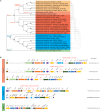Distribution, Function and Regulation of Type 6 Secretion Systems of Xanthomonadales
- PMID: 31379785
- PMCID: PMC6653060
- DOI: 10.3389/fmicb.2019.01635
Distribution, Function and Regulation of Type 6 Secretion Systems of Xanthomonadales
Abstract
Members of the Xanthomonadales order include several plant pathogens of significant economic and agricultural impact, such as Xanthomonas spp. Type 6 secretion systems (T6SSs) are contractile nanomachines used by many bacterial species to inject protein effectors into target prokaryotic and eukaryotic cells and provide a competitive advantage for bacteria in different environments. Effectors with antibacterial properties include peptidoglycan hydrolases, lipases and phospholipases that break down structural components of the cell envelope, promoting target-cell lysis; and RNases, DNAses, and NADases that affect target-cell metabolism, arresting growth. Effectors with anti-eukaryotic properties are functionally more diverse. The T6SS of Xanthomonas citri is the only example experimentally characterized so far within the Xanthomonadales order and displays anti-eukaryotic function by providing resistance to predation by amoeba. This T6SS is regulated at the transcriptional level by a signaling cascade involving a Ser/Thr kinase and an extracytoplasmic function (ECF) sigma factor. In this review, we performed in silico analyses of 35 genomes of Xanthomonadales and showed that T6SSs are widely distributed and phylogenetically classified into three major groups. In silico predictions identified a series of proteins with known toxic domains as putative T6SS effectors, suggesting that the T6SSs of Xanthomonadales display both anti-prokaryotic and anti-eukaryotic properties depending on the phylogenetic group and bacterial species.
Keywords: T6SS; Xanthomonadales; Xanthomonas; amoeba predation; bacterial killing; effectors; toxins.
Figures

Similar articles
-
The AraC-type transcription factor TagK is a new player in the signaling cascade that induces the anti-eukaryotic T6SS of Xanthomonas citri.Mol Microbiol. 2022 Nov;118(5):552-569. doi: 10.1111/mmi.14985. Epub 2022 Oct 17. Mol Microbiol. 2022. PMID: 36164821
-
Xanthomonas citri T6SS mediates resistance to Dictyostelium predation and is regulated by an ECF σ factor and cognate Ser/Thr kinase.Environ Microbiol. 2018 Apr;20(4):1562-1575. doi: 10.1111/1462-2920.14085. Epub 2018 Mar 26. Environ Microbiol. 2018. PMID: 29488354
-
A Transcriptional Regulatory Mechanism Finely Tunes the Firing of Type VI Secretion System in Response to Bacterial Enemies.mBio. 2017 Aug 22;8(4):e00559-17. doi: 10.1128/mBio.00559-17. mBio. 2017. PMID: 28830939 Free PMC article.
-
The T6SSs of Pseudomonas aeruginosa Strain PAO1 and Their Effectors: Beyond Bacterial-Cell Targeting.Front Cell Infect Microbiol. 2016 Jun 9;6:61. doi: 10.3389/fcimb.2016.00061. eCollection 2016. Front Cell Infect Microbiol. 2016. PMID: 27376031 Free PMC article. Review.
-
The Versatile Type VI Secretion System.Microbiol Spectr. 2016 Apr;4(2):10.1128/microbiolspec.VMBF-0026-2015. doi: 10.1128/microbiolspec.VMBF-0026-2015. Microbiol Spectr. 2016. PMID: 27227310 Free PMC article. Review.
Cited by
-
The Succession of Bacterial Community Attached on Biodegradable Plastic Mulches During the Degradation in Soil.Front Microbiol. 2021 Dec 24;12:785737. doi: 10.3389/fmicb.2021.785737. eCollection 2021. Front Microbiol. 2021. PMID: 35046914 Free PMC article.
-
The type VI secretion system of Stenotrophomonas rhizophila CFBP13503 limits the transmission of Xanthomonas campestris pv. campestris 8004 from radish seeds to seedlings.Mol Plant Pathol. 2024 Jan;25(1):e13412. doi: 10.1111/mpp.13412. Mol Plant Pathol. 2024. PMID: 38279854 Free PMC article.
-
Cassava diseases caused by Xanthomonas phaseoli pv. manihotis and Xanthomonas cassavae.Mol Plant Pathol. 2021 Dec;22(12):1520-1537. doi: 10.1111/mpp.13094. Epub 2021 Jul 6. Mol Plant Pathol. 2021. PMID: 34227737 Free PMC article. Review.
-
Secrete or perish: The role of secretion systems in Xanthomonas biology.Comput Struct Biotechnol J. 2020 Dec 24;19:279-302. doi: 10.1016/j.csbj.2020.12.020. eCollection 2021. Comput Struct Biotechnol J. 2020. PMID: 33425257 Free PMC article. Review.
-
Genomic and phenotypic insight into Xanthomonas vesicatoria strains with different aggressiveness on tomato.Front Microbiol. 2023 Jun 27;14:1185368. doi: 10.3389/fmicb.2023.1185368. eCollection 2023. Front Microbiol. 2023. PMID: 37440880 Free PMC article.
References
-
- Bayer-Santos E., Lidia dos Passos L., de Moraes Ceseti L., Ratagami C. Y., de Santana E. S., da Silva A. M., et al. (2018). Xanthomonas citri T6SS mediates resistance to Dictyostelium predation and is regulated by an ECF σ factor and cognate Ser/Thr kinase. Environ. Microbiol. 20 1562–1575. 10.1111/1462-2920.14085 - DOI - PubMed
Publication types
LinkOut - more resources
Full Text Sources
Molecular Biology Databases
Miscellaneous

